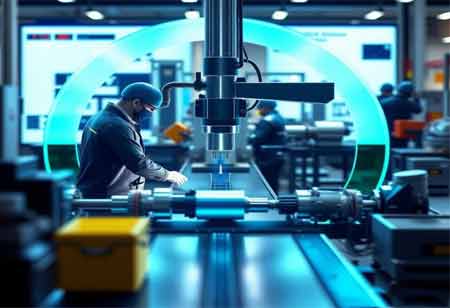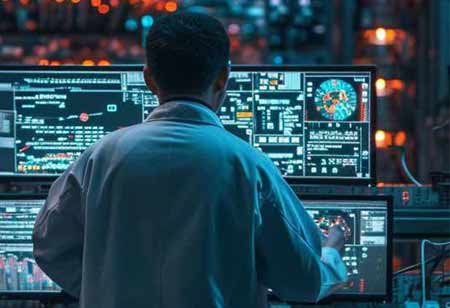THANK YOU FOR SUBSCRIBING

Using Digital Twins to Reduce Carbon Emissions in the Manufacturing Industry: The Identification of Non-productive Emissions
Dr Michael Lees, Control & Automation Manager, Carlton & United Breweries

 Dr Michael Lees, Control & Automation Manager, Carlton & United Breweries
Dr Michael Lees, Control & Automation Manager, Carlton & United BreweriesDigital twins are increasingly espoused as an effective means of improving the efficiency of manufacturing plants and minimising their associated carbon footprint.
Indeed, the link between the digitisation paradigm and its impact (on both business and the environment) is sometimes regarded as self-evident or obvious. This sentiment is often fortified by the promise of things like high-fidelity measurement, on-line monitoring and scenario analysis; all to yield performance-improving insights. However, simply having access to more data, metrics and analytical capability does not in and of itself guarantee an improvement, let alone support a business case for the implementation of such a platform.
The global digital twin market is projected to grow substantially over the next decade. Some reports have valued the market at around USD 8.6 billion in 2022 with projected growth through USD 11.51 billion in 2023 and up to over USD 137 billion by 2030. However, the projected spend of others is not evidence of a return on investment for you. Indeed, history has no shortage of market-led IT-related paradigms that have resulted in financially unfavourable outcomes for some companies. Arguably, in many cases, the absence of a quality realistic business case (with ROI determination) is a likely common factor.
So the question then becomes, ‘What specifically could you target with a digital twin that could increase your likelihood of identifying opportunities for improvement and for making an impact?’
New insights into the capacity for waste reduction
An established ever-present but appealing pathway is the identification and reduction of waste. As the reduction of waste and the improvement of yield and efficiency all have clear established links to profitability, they have long been a focus of the manufacturing industry. These concepts and their subsequent emerging frameworks are far from novel. The essence of the Lean Manufacturing paradigm is the ‘systematic elimination of waste’.
So, what specifically could digital twins offer in this space that could justify the required investment?
The answer to this question depends in part on the initial level of the ‘maturity’ of the manufacturing plant (in terms of informatics, automation and energy management programs). Plants of lower maturity have typically (and by definition) not yet identified and exhausted the easy wins (low hanging fruit) especially in the context of energy efficiency and emissions reduction. In such cases the offering and potential impact of digital twins are more likely to be broader, greater and more obvious.
"No one wins if end users do not realize a return on their digitization investment."
So, for the more mature plants (that are by definition probably already efficient), how can the remaining opportunities (higher hanging fruit) be identified?
Monitoring non-productive consumption
One way of contextualising the (waste-reduction) opportunities is through the lens of Non-Productive Consumption (NPC). This can be defined as the portion of the consumed energy/utilities that could be reduced without reducing the quality or quantity of the saleable product. By extension – Non- Productive Greenhouse gas Emissions (NGE) would be the portion of emissions that are a result of NPC.
Contemporary manufacturing plants typically monitor energy and utilities consumption with KPI metrics that are normalised against quantity of product produced. Normalised metrics attempt to present figures that are somewhat independent to variations in production output, to enable performance comparisons between lines/plants over time. However, they are not able to provide any real indication of the opportunity for improvement (i.e., ‘waste’ identification and quantification). Whereas the purpose of the NPC metric is to directly measure the actual waste (opportunity for improvement).
In a simplified example in the context of a manufacturing plant in the Food & Beverage industry, the NPC could span three aspects of production and could include:
1. Packaging materials: The portion of packaging materials that don’t make it to finished saleable product (including finished but non-saleable product)
2. Product: This includes the loss of both not-yet-packaged product during the production process, as well as within finished non-saleable packaged product
3. Energy & Utilities
● Idle runs (periods of time in between actual production runs where the production line is on/powered-up, temperatures are maintained and compressed air systems are at pressure)
● Efficiency gap (loss): The energy consumption of a production run as compared to past best performance for a similar volume of the same product on the same production line
Many of these aspects are not trivial to incorporate into an automated sustainable NPC metric (especially the efficiency gap). They require the integration of accurate plant floor data (segregated by production run or batch) with higher-level database content on material and products.
There is no real way to objectively measure the upper limit for ‘maximum efficiency’ as it will change over time as the inherent efficiency of new equipment improves. One of the strengths of the Efficiency gap component of the NPC metric is that it provides a relative comparison against the best performance that has actually been achieved on the same plant/line for the same product. Hence, by definition, it is a real achievable target. Another advantage of this type of metric is that it is inherently adaptive as the target will change over time as the line becomes more efficient.
While Industry 4.0 infrastructure could be sufficient for monitoring NPC, digital twins have the potential to provide a greater opportunity to improve NPC. In addition to providing the infrastructure that is required for high fidelity measurement and identification of NPC, digital twins enable simulation-based scenario analysis of the impact that changes to equipment and processes could have on NPC. Some more specific examples could include such things as:
● Simulate the impact of energy-aware scheduling on product sequence, idle runs and ultimately NPC
● Simulate the impact of product sequence (change-over and run-out) on packaging yield
● Compare the NPC for production of the same SKU across different lines (and plants)
● Provide quantified evidence-based input into the determination of minimum viable run-length (map the NPC by production run-length)
● Compare NPC variation (for the same line and SKU) by shift/operator-crew
It is not the tool (digital twin) that will bring you success, it is what you do with it
While Digital Twin platforms promise a wealth of different opportunities for business impact, they are typically a significant investment. A strong business case can help to garner the support to acquire one and importantly to increase the likelihood of realising the aspired return on investment.
Waste reduction is an ever-appealing direction as it can be very profitable while also reducing the environmental impact of the business (and consequentially of its upstream supply chain). It can sometimes also result in an effective capacity increase of the plant. Waste reduction opportunities become progressively more difficult to find in plants that are not new to this journey and are already somewhat efficient.
Having a specific pathway to focus on (such as NPC) can support and strengthen a business case as well as improve the realised return on investment. Importantly, a focus on NPC can provide a pragmatic and structured pathway to quantify and predict a realistic and achievable target. The digital twin paradigm provides the required informatics infrastructure and scenario analysis opportunity to enable NPC to be both monitored and improved.
Read Also






















ON THE DECK